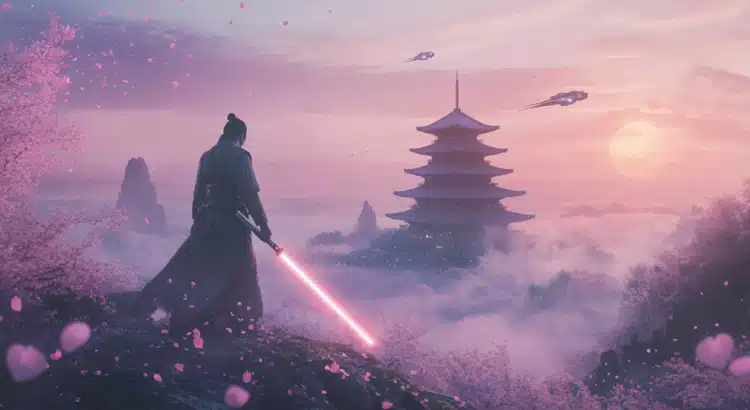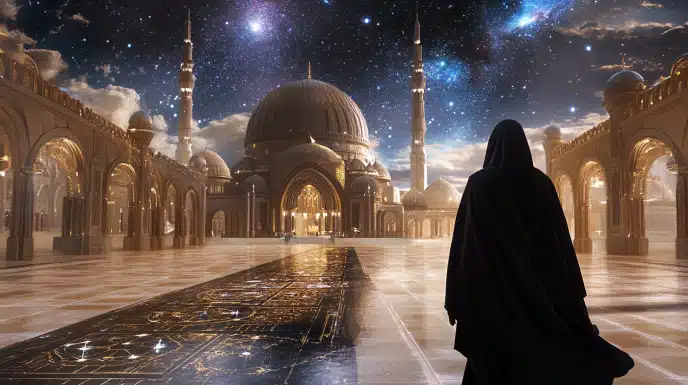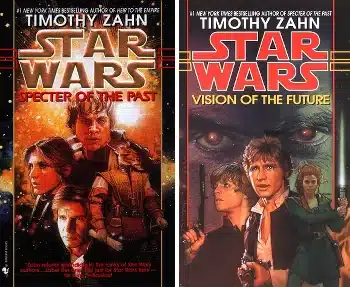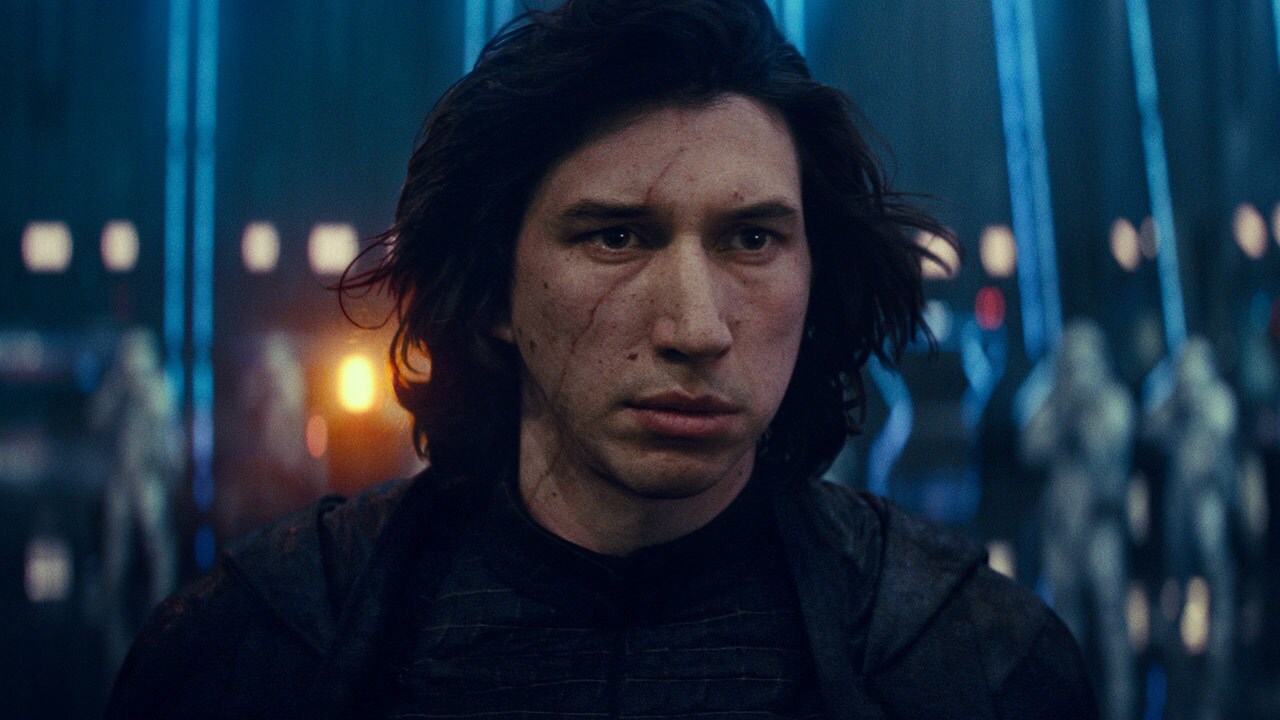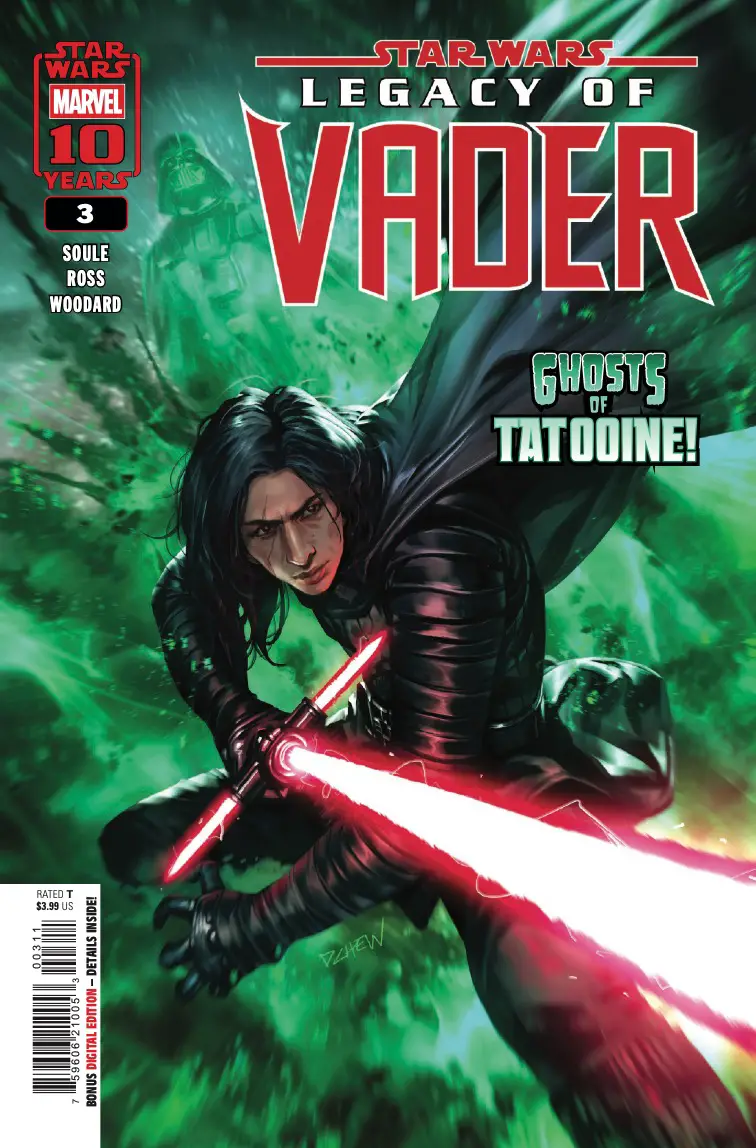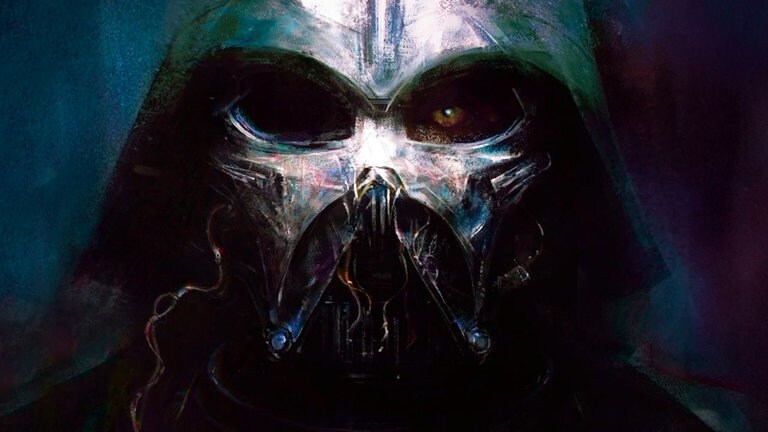As Star Wars Celebration Japan 2025 approaches, there’s no better time to revisit a truth that’s long been encoded in the DNA of the galaxy far, far away: Star Wars is deeply influenced by Japanese culture.
Before the Jedi donned robes and raised their lightsabers, before Darth Vader became the face of cinematic villainy, and before the first spaceship ever roared across a silver screen, Star Wars was already drawing from a rich and ancient source: Japanese culture.
As Star Wars Celebration Japan 2025 approaches, it’s the perfect time to reflect on how deeply the saga is rooted in Japan’s artistic, philosophical, and martial traditions. Because Star Wars isn’t just an epic space opera—it’s a cultural fusion. A mythic tale told through the lens of samurai ethics, Zen philosophy, and the cinematic brilliance of Akira Kurosawa.
From the silent strength of Darth Vader’s armor—shaped by samurai design—to the spiritual weight of the Force—echoing the meditative teachings of Zen—Japanese influence flows through nearly every frame of Star Wars. And it’s not just in the visuals. It’s in the storytelling structure. It’s in the moral dilemmas. It’s in the quiet tension of a lightsaber duel, and the inner conflict of a hero choosing peace over power.
This article explores the profound impact of Japanese cinema, philosophy, and aesthetics on the galaxy George Lucas built. We’ll dive into Kurosawa’s influence on character and plot, examine the shared DNA between Jedi and samurai, unpack the Zen-like nature of the Force, and decode the visual language that gives Star Wars its timeless feel.
Because sometimes, to understand where a galaxy far, far away truly begins—you have to look East.
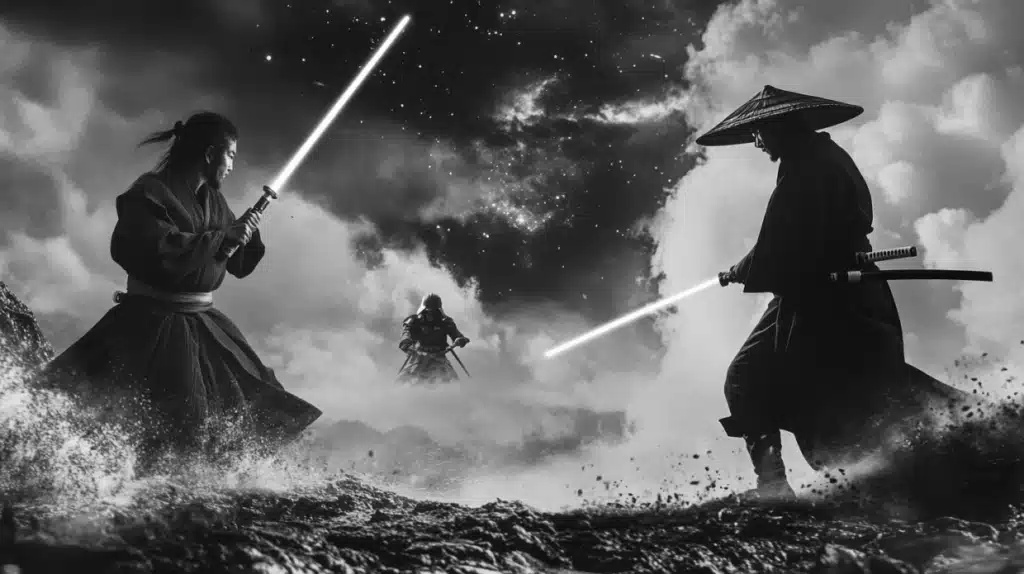
Akira Kurosawa: The Master Who Inspired a Universe
Before there was a Death Star, a Skywalker saga, or a lightsaber duel under twin suns, there was Akira Kurosawa—the legendary Japanese filmmaker whose work laid the cinematic foundation for what would become Star Wars. For George Lucas, Kurosawa wasn’t just an influence—he was a blueprint. And once you know what to look for, his fingerprints are all over the galaxy far, far away.
The Hidden Fortress: The Original Star Wars Draft?
When Lucas first began developing Star Wars in the early 1970s, he didn’t have a fully formed saga—he had a love letter to Kurosawa. The most direct influence came from The Hidden Fortress (1958), a Japanese period film about a princess, a general, and two bumbling peasants navigating war-torn feudal Japan.
Sound familiar? It should.
- The two comic relief peasants, Tahei and Matashichi, serve as the original mold for C-3PO and R2-D2—narrating the story from the ground up, just like the droids in A New Hope.
- The disguised princess, hunted by enemies but noble in spirit, prefigures Princess Leia.
- The stoic, tactical general played by Toshiro Mifune—a character George Lucas reportedly wanted Mifune himself to play in Star Wars—became the inspiration for Obi-Wan Kenobi.
Even the visual storytelling—the use of wipe transitions, long tracking shots, and panoramic landscapes—was directly pulled from Kurosawa’s style. Lucas once said that The Hidden Fortress helped him figure out how to “tell the story from the periphery,” which is why A New Hope begins not with Luke or Leia, but with R2-D2 and C-3PO.
🎬 “I was trying to make a modern fairy tale, and Kurosawa already had the structure.” — George Lucas on Kurosawa
Seven Samurai and the Blueprint for Heroism
Another towering influence came from Seven Samurai (1954), often considered one of the greatest films ever made. It tells the story of masterless warriors who band together to protect a helpless village. Swap out the village for the Rebellion and the samurai for Jedi or rebels, and you’ve got the emotional skeleton of Rogue One, The Mandalorian, and even The Clone Wars.
This archetype—the reluctant hero who fights for a greater cause—is at the core of the Star Wars ethos. Kurosawa’s characters weren’t born noble; they chose to act selflessly in the face of injustice. Lucas carried that idea directly into Luke Skywalker’s journey, and it has echoed across nearly every Star Wars protagonist since.
Kurosawa also inspired the group dynamic storytelling that Star Wars uses so effectively: different personalities forced to work together, each with their own strengths and flaws. Think about the original trio—Luke, Leia, and Han—and how they mirror Kurosawa’s ensembles of idealists, skeptics, rogues, and leaders.
Toshiro Mifune: The Jedi That Almost Was
One of the great “what if” moments in Star Wars history involves Toshiro Mifune, Kurosawa’s most iconic leading man. Known for his powerful presence and quiet intensity, Mifune was Lucas’s top choice to play Obi-Wan Kenobi—a role that eventually went to Alec Guinness.
Had Mifune accepted, the Jedi Order might have had a very different on-screen identity, leaning even more heavily into samurai imagery and Japanese acting traditions. While Mifune declined—reportedly worried that a sci-fi film might diminish the dignity of the samurai—his legacy still lingers in Obi-Wan’s quiet strength, discipline, and moral resolve.
Philosophy, Pace, and Visual Language
Kurosawa didn’t just influence what Star Wars showed—he influenced how it felt.
His films were known for their deliberate pace, moral ambiguity, and visual storytelling. He used the weather, silence, body language, and careful framing to convey tension. The rain-soaked duel in Rashomon, the stoic stare-downs in Yojimbo, and the wind-whipped robes of Throne of Blood—these techniques would later show up in Star Wars lightsaber duels, especially the more meditative confrontations between Jedi and Sith.
Kurosawa’s characters often wrestled with internal conflict, social duty, and ethical dilemmas—the very same themes that make Anakin’s fall or Luke’s restraint in Return of the Jedi so powerful.
Legacy in Every Frame
The reverence Lucas had for Kurosawa didn’t end with the original trilogy. His influence continued through prequels, animation, and even recent projects like Visions, the anime anthology that openly embraces Japanese storytelling and aesthetics.
And it’s not just Lucas—other creators within the Star Wars universe, from Dave Filoni (The Clone Wars, Rebels) to Rian Johnson (The Last Jedi), have carried Kurosawa’s DNA forward. You can see it in the way duels are framed, in characters who choose mercy over violence, and in the thematic weight placed on honor, sacrifice, and balance.
Why It Matters Today
With Star Wars Celebration Japan 2025 just around the corner, there’s no better moment to honor Kurosawa’s legacy and his pivotal role in shaping Star Wars. His films didn’t just influence the look and feel of the saga—they embedded timeless lessons into its core: about humanity, purpose, and the quiet power of choosing the right path—even when it’s the hardest one.
As we celebrate both the future of Star Wars and its deeply rooted past, we’re reminded that the journey from feudal Japan to a galaxy far, far away is only a creative leap away.
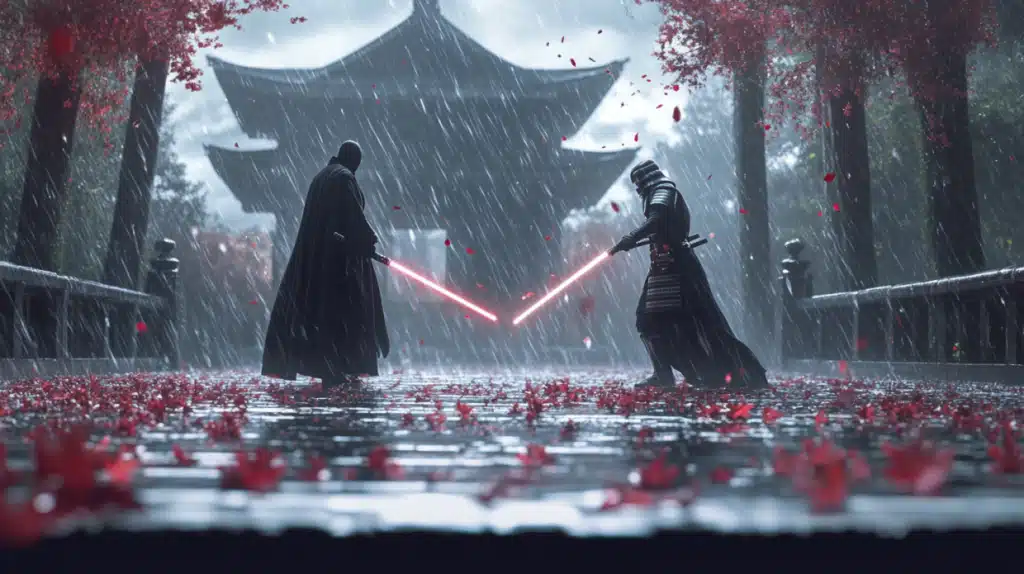
Jedi and Sith: Space Samurai with Spiritual Depth
The Jedi are often called “space monks,” but let’s be honest—they’re also space samurai.
Their robes, their calm demeanor, their sense of honor, and of course, their lightsabers—all reflect samurai aesthetics and philosophy. In fact, George Lucas has openly acknowledged the connection, and the influence runs deep, not just visually but spiritually.
The design of the lightsaber is functionally futuristic, yes—but its purpose, its ritual, and its symbolism mirror that of the katana, the sacred sword of the samurai. Both are treated with reverence. Both require training, respect, and emotional control. And both are seen as extensions of the wielder’s soul.
The Jedi Code and the Way of Bushido
Just as the Jedi follow a strict moral and spiritual code, so too did the samurai adhere to Bushidō—the “Way of the Warrior.” It wasn’t just a set of rules for combat, but a complete ethical system that shaped how a samurai lived, fought, and died. Many of the core values align directly with Jedi teachings:
- Honor: Jedi are expected to act with integrity, even when no one is watching.
- Courage: Facing danger without fear—especially the fear of loss—is central to Jedi discipline.
- Benevolence: Jedi protect the innocent, acting as peacekeepers rather than aggressors.
- Respect for Life: Jedi choose negotiation over violence unless absolutely necessary.
- Loyalty: To the Republic, to the Jedi Order, and to the greater good.
- Self-Discipline: Jedi must control their emotions and reject personal attachments.
These are not just rules—they’re a way of life. For both the samurai and the Jedi, breaking the code isn’t just a failure—it’s a loss of identity and purpose. It’s no coincidence that fallen Jedi often describe themselves as being “lost” or “without a path.”
The Sith as Ronin: Fallen Warriors with No Master
If the Jedi reflect the disciplined honor of samurai, the Sith embody the opposite: they are the ronin—masterless warriors who have rejected the code.
In Japanese history, ronin were often portrayed as tragic figures: former samurai who had lost their lords and, with them, their place in society. Some upheld the Bushido code on their own terms. Others turned to mercenary work, crime, or revenge—driven by grief, anger, or ambition.
Sound familiar?
- Count Dooku left the Jedi, claiming the Order had become corrupt.
- Anakin Skywalker fell to fear and attachment, becoming Darth Vader, a Sith driven by rage and regret.
- Kylo Ren is perhaps the most ronin-like figure—torn between teachings, trying to forge his own path with no true master to guide him.
The Sith, like many ronin, operate by their own code—if any. They are driven by passion, personal power, and the pursuit of dominance. While the Jedi believe in serving the galaxy, the Sith serve themselves. Where the Jedi seek balance, the Sith embrace imbalance as a source of strength.
Dueling Philosophy: Precision, Purpose, and Spiritual Combat
Jedi and Sith lightsaber combat also channels the traditions of kenjutsu and iaido—the Japanese martial arts of the sword.
- Jedi duels are slow, deliberate, and emotionally charged—much like traditional samurai sword duels.
- Each movement carries spiritual weight, not just physical threat.
- A single strike can be decisive, echoing the belief that a duel should be resolved with precision, not chaos.
Even the ritual of constructing a lightsaber parallels the samurai’s reverence for the katana. In Star Wars: The Clone Wars, young Jedi undergo a rite of passage to build their own weapon—choosing a kyber crystal, meditating, assembling the hilt with the Force. The process is intimate, sacred, and personal. Just as samurai would inherit or forge their katana as a symbol of their lineage and honor, Jedi do the same with their lightsabers.
A Shared Legacy of Discipline and Destiny
In the end, the parallels between Jedi and samurai aren’t just surface-level. They reflect a deeper connection—a shared legacy of discipline, duty, and spiritual depth.
- Both serve a higher cause.
- Both live and die by a code.
- Both understand that real strength comes from within, not from domination or fear.
And just like in feudal Japan, the path of the warrior in Star Wars is not simply about fighting—it’s about becoming. Becoming balanced. Becoming mindful. Becoming worthy of the power you wield.
In a galaxy filled with blasters, empires, and rebellion, the Jedi remind us of something older, quieter, and infinitely powerful: the warrior’s path is one of wisdom, restraint, and responsibility.osophy is the inverse of Bushido—instead of serving others, they serve themselves.
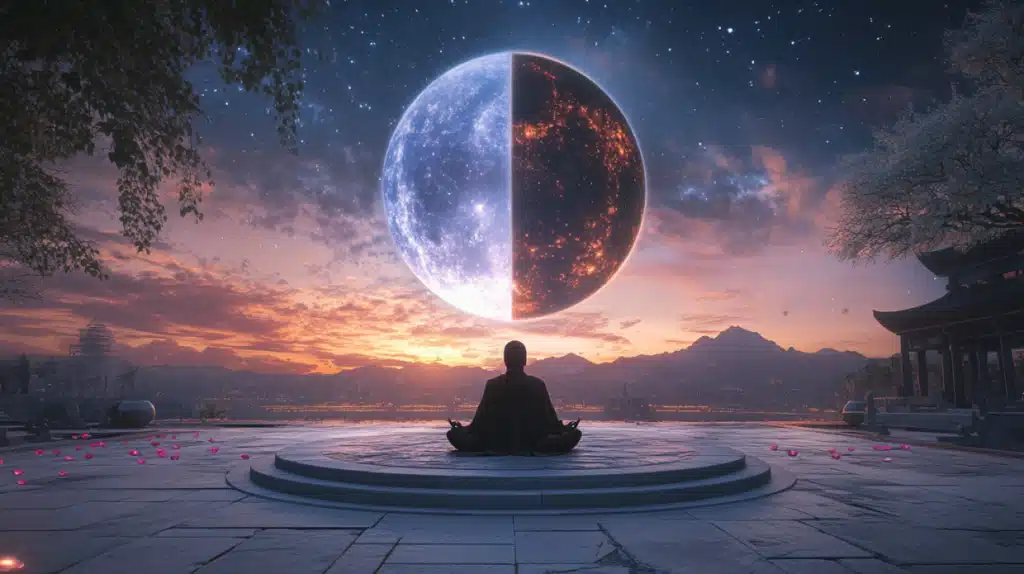
The Force and Zen Buddhism: A Balance of Opposites
“The Force surrounds us. It penetrates us. It binds the galaxy together.”
With those iconic words, Star Wars introduced not just a sci-fi power system—but a spiritual philosophy. The Force, as described by Jedi Masters like Obi-Wan and Yoda, is more than just a plot device. It’s a reflection of a deeper worldview—one that draws heavily from Eastern spirituality, particularly Zen Buddhism.
And as Star Wars Celebration Japan 2025 approaches, it’s the perfect time to explore how the philosophy of balance, discipline, and detachment in Star Wars aligns closely with Zen thought—and how that ancient wisdom continues to shape the Jedi, the Sith, and the galaxy far, far away.
The Path to Enlightenment… or the Dark Side
At the heart of both the Jedi Order and Zen Buddhism lies the idea that enlightenment comes not from action—but from awareness. From stillness. From mastering the self.
In Zen practice, the goal is satori—a sudden awakening or deep insight into the true nature of reality. This is achieved not through rigid doctrines or lengthy sermons, but through meditation (zazen), mindfulness, and detachment from the ego.
The Jedi pursue a similar path. They meditate. They seek inner calm. They are trained to let go of fear, anger, and attachment. In fact, Jedi teachings often sound like they could be lifted straight from a Zen monastic retreat:
“Train yourself to let go of everything you fear to lose.”
— Yoda
That’s not just Jedi advice. It’s classic Zen. It reflects the belief that clinging leads to suffering, and that inner peace comes only when one stops grasping at control, power, or permanence.
Duality and Balance: Light and Dark, Yin and Yang
Zen philosophy is deeply influenced by the concept of duality and harmony, much like the Taoist principle of yin and yang—which, while distinct from Zen, often coexists with it in East Asian spiritual practice.
This duality is central to Star Wars. The Light Side and Dark Side of the Force are not separate entities, but interdependent forces. The Jedi seek balance, not domination. The Sith seek power, not peace. And yet—both are connected.
“The Force is what gives a Jedi his power. It’s an energy field created by all living things.” — Obi-Wan Kenobi
This idea—that all things are connected through a living, flowing energy—is remarkably similar to the Buddhist idea of interdependence (pratītyasamutpāda). Nothing exists independently. All things arise together, bound by cause, effect, and perception.
The Jedi’s approach to the Force mirrors this non-dualistic worldview, where light and dark aren’t “good” and “evil” in simple terms—but manifestations of intention, action, and inner balance.
Mindfulness, Meditation, and the Jedi Way
Zen Buddhism emphasizes mindfulness, the practice of being fully present in each moment. Whether performing a daily ritual, drinking tea, or sitting in silence, the Zen practitioner seeks clarity not by escaping the moment—but by sinking deeply into it.
This is reflected in how Jedi are trained:
- They meditate to center themselves.
- They act without haste, without emotion clouding judgment.
- They are taught to be present—to feel, not to overthink.
“Your eyes can deceive you; don’t trust them.”
— Obi-Wan, reminding us that truth is found within, not through sensory illusion.
Compare this to the Sith, who are impulsive, emotionally driven, and obsessed with controlling outcomes. Where the Jedi seek stillness, the Sith seek certainty. But as Zen teaches, trying to control reality only leads to suffering.
Letting Go of Attachment: Jedi Detachment vs. Buddhist Non-Attachment
One of the most controversial Jedi tenets is their stance on attachment. Anakin Skywalker’s fall to the dark side is rooted in his inability to let go—his obsessive attachment to Padmé, to control, and to the fear of loss.
The Jedi teach that attachment leads to fear, fear leads to anger, anger leads to hate, and hate leads to suffering. And that’s basically a paraphrase of Buddha’s Four Noble Truths, which center on the idea that desire (tanha) is the root of suffering.
But it’s important to distinguish: non-attachment is not indifference. In Buddhism, and in the Jedi Code, you can love. You can care. You just can’t cling. True compassion comes from selfless action, not possessiveness. It’s about giving without expecting. Protecting without controlling.
Anakin loved Padmé—but he couldn’t let her go.
Luke loved his father—but he chose mercy, not possession.
And that’s the difference between attachment and compassion, between the dark side and the light.
The Zen of Lightsabers: Simplicity, Precision, Intuition
Zen is about simplicity. The stripping away of distractions. The perfection of form.
And you see that in lightsaber combat, particularly among Jedi. Their fighting style isn’t flashy or chaotic. It’s minimal, efficient, and flowing like water—just like a Zen martial art.
- Each movement is intentional.
- Each strike has purpose.
- Victory comes not through brute strength, but through internal alignment.
This is particularly clear in characters like Yoda, Qui-Gon Jinn, and Luke Skywalker—who all emphasize peace, restraint, and presence over dominance.
🧘 In Zen, the goal isn’t to defeat the opponent—it’s to defeat the ego. Sounds like a Jedi mantra, doesn’t it?
Why It Still Resonates
The reason the Force resonates with so many people isn’t just because it’s mysterious or magical. It’s because it taps into spiritual archetypes that have guided humanity for centuries. Zen Buddhism gave Lucas a framework for showing that true power lies not in conquest, but in surrender; not in fear, but in acceptance; not in domination, but in balance.
And as Star Wars continues to evolve—with new characters, new Force users, and new perspectives—this ancient spiritual foundation still grounds it. Whether it’s Rey finding peace in silence, or Luke choosing to throw away his saber rather than strike, the message remains:
Balance, clarity, and compassion are stronger than fear, anger, or control.
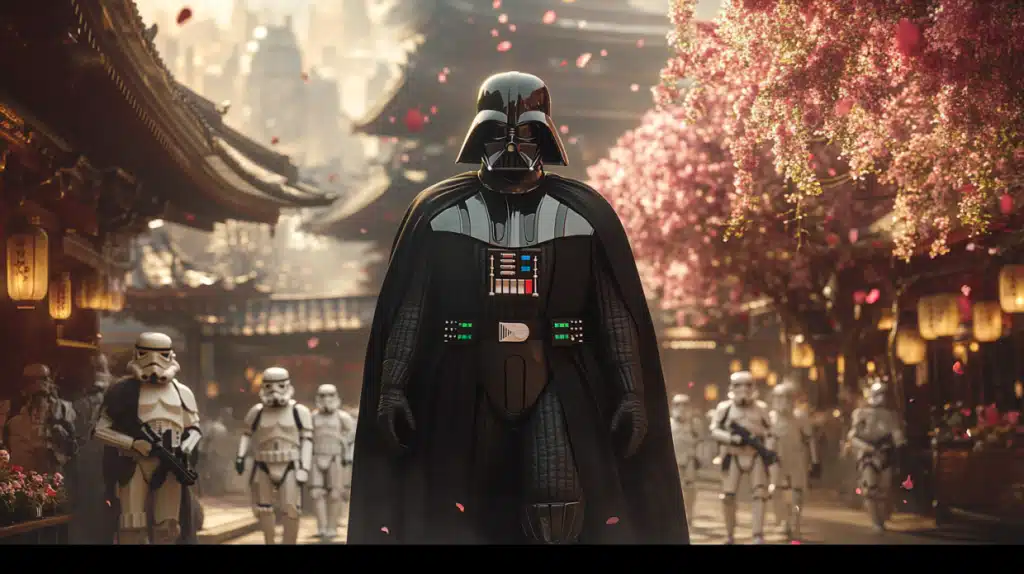
Design Aesthetics: From Armor to Architecture
Star Wars is known for its epic storytelling, mythic themes, and memorable characters—but just as important is how the galaxy looks. The visual design of Star Wars is instantly recognizable: cloaked Jedi in sparse, serene temples, stormtroopers in gleaming white armor, and a menacing Sith Lord dressed in flowing black with a helmet that screams fear.
But look a little closer, and you’ll see something fascinating: the visual language of Star Wars is deeply rooted in Japanese aesthetics, particularly from the samurai era. From costume design to architectural styles, the saga wears its cultural inspirations proudly, blending historical motifs with futuristic flair to create a galaxy that feels both ancient and new.
Darth Vader: The Sith Lord in Samurai Armor
Let’s start with the most iconic villain in cinema history: Darth Vader.
His helmet and face mask were directly inspired by the kabuto, the ornate battle helmet worn by Japanese samurai. The flared shape, the menacing mask, the vertical slits—they all echo the design of menpō (facial armor), which was worn to both protect the warrior and intimidate enemies.
The resemblance isn’t coincidental. Costume designer Ralph McQuarrie and George Lucas worked closely to infuse Vader with the presence of a modern mythic warlord. His black robes and shoulder armor even mimic the do-maru, a type of lamellar armor used by samurai in the 11th century.
🖤 The result? A character that visually evokes fear, discipline, and power—all qualities associated with high-ranking samurai.
Jedi Robes and the Zen Aesthetic
While Vader’s armor channels the warrior, the Jedi robes evoke the monk.
The Jedi dress simply: loose-fitting, earth-toned robes reminiscent of Buddhist monks or wandering ronin (masterless samurai). This simplicity isn’t just a design choice—it’s a reflection of Zen philosophy, which values humility, detachment, and minimalism.
The folds in their robes echo the aesthetic of wabi-sabi, a Japanese worldview centered on the beauty of imperfection and impermanence. Their muted tones visually separate them from the technological excess of the Galactic Empire. In other words, the Jedi look like spiritual ascetics, not soldiers—even when wielding glowing laser swords.
Compare that to the Sith, whose clothing is often darker, more angular, and more theatrical—visually communicating their obsession with power, fear, and control.
Samurai Influence in Lightsaber Duels
Beyond robes and helmets, the choreography of lightsaber battles also borrows from Japanese martial traditions. Early duels, especially those in the original trilogy, are inspired more by kenjutsu (traditional Japanese swordsmanship) than by Western fencing.
- Combat is slow and deliberate
- Movements are purposeful, not flashy
- Each strike is emotionally loaded, not just physical
In The Phantom Menace, for example, the duel between Qui-Gon Jinn, Obi-Wan Kenobi, and Darth Maul has moments of stylized intensity, but it still retains a certain zen-like flow and rhythm—reminiscent of samurai film showdowns, particularly in the works of Kurosawa.
Temples, Courtyards, and the Spirit of Space
Now let’s talk architecture.
The Jedi Temple on Coruscant isn’t just a monument to the Order—it’s a spiritual sanctuary. Its vertical spires and central dome resemble the structure of Buddhist temples and Japanese pagodas, blending religious design with futuristic aesthetics. The long corridors, open meditation chambers, and elevated halls evoke a sense of quiet contemplation—perfectly suited to a monastic warrior class.
Other locations in the Star Wars universe also carry architectural DNA from Islamic and East Asian designs:
- Naboo’s Theed Palace features symmetry, domes, and courtyards reminiscent of Japanese imperial residences and Islamic palaces.
- Dagobah’s cave is simple, natural, and symbolically rich—reminiscent of Zen gardens and the use of nature in Japanese spiritual architecture.
- Even Star Destroyers and the Death Star contrast this with brutalist, militaristic symmetry—suggesting a regime devoid of soul and spirituality.
In each case, the built environment reflects philosophy: the Jedi value peace and balance, so their spaces feel meditative. The Sith value dominance, so their environments are sharp, cold, and oppressive.
Color Theory and Symbolism
Japanese art places great importance on color, and Star Wars mirrors this approach in character design:
- White armor: worn by stormtroopers, suggests faceless uniformity and obedience—like ashigaru infantry in feudal Japan.
- Black robes and helmets: used by Sith Lords to signal authority, menace, and detachment from compassion.
- Earth tones: favored by the Jedi to express humility and harmony with nature.
This color coding isn’t accidental—it’s a direct nod to how visual storytelling in Japanese cinema and traditional art communicates emotional and philosophical themes.
Why It Works: Ancient Aesthetic, Timeless Appeal
Part of what makes Star Wars visually timeless is its ability to combine the old with the new—blending ancient, recognizable styles with futuristic elements that feel plausible and grounded. Japanese design principles, especially from the samurai and Zen traditions, offer that balance perfectly.
The minimalism, the spiritual undertones, the sense of ceremony—it all reinforces the story’s core themes: discipline, duality, and destiny.
In a galaxy of hyperspace lanes and talking droids, the presence of quiet temples, solemn warriors, and ritualistic weaponry gives Star Wars its mythic depth.
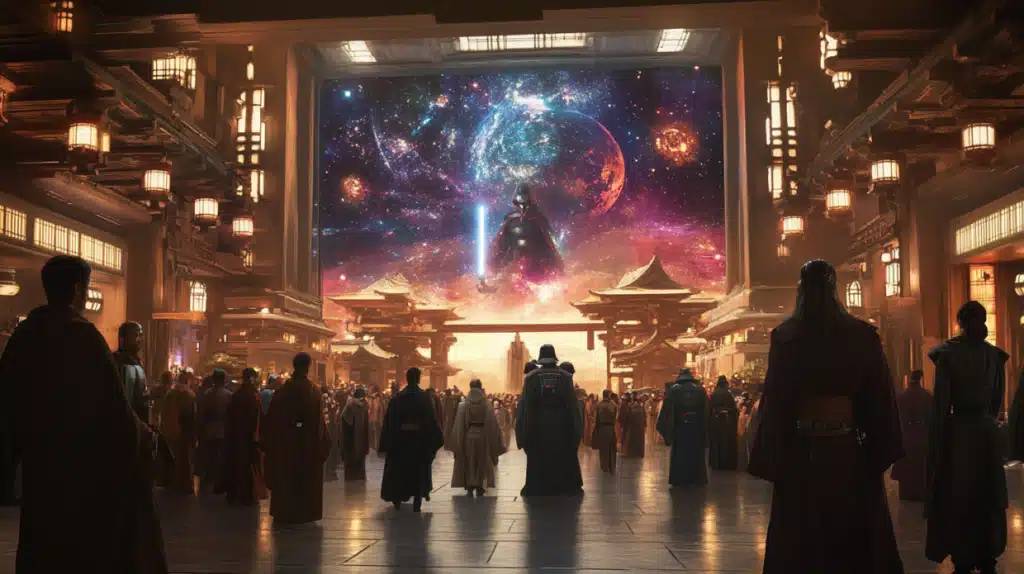
Why It Still Resonates Today
Decades after its debut, Star Wars continues to capture the imaginations of audiences around the world—not just because of its epic battles and space operas, but because of the cultural depth baked into its design, philosophy, and storytelling. And nowhere is that depth more evident than in its relationship with Japanese culture.
The influence of samurai values, Zen Buddhism, and Kurosawa’s cinematic style didn’t just shape Star Wars into a compelling narrative—it gave it soul. And in an age where science fiction often leans heavily into spectacle, Star Wars remains grounded by timeless themes of honor, balance, and inner struggle.
Modern Storytelling Built on Ancient Foundations
When people say Star Wars feels “mythic,” they’re not wrong. It draws from global traditions—particularly Japanese storytelling and spiritual philosophy—to build a galaxy that feels both vast and deeply personal. And that duality resonates with viewers of all backgrounds.
- The Jedi Code, rooted in Zen detachment and Bushido honor, continues to speak to anyone who values self-discipline over chaos.
- The Sith, representing unchecked ego and desire, reflect the very human temptation toward power, control, and fear.
- The tension between the Light and Dark isn’t just good vs. evil—it’s a philosophical struggle within every person, reminiscent of teachings found in Buddhist and samurai traditions.
These aren’t just plot mechanics. They’re spiritual blueprints, and they’ve helped Star Wars endure through generations.
A Cultural Bridge That Inspires New Generations
In a world that’s more connected than ever, Star Wars stands out as a cultural bridge—a franchise born in the West, but shaped by the East. Its widespread popularity has introduced millions of people to the aesthetics, values, and philosophies of Japanese culture—whether they realize it or not.
This is especially meaningful as the saga continues to evolve with shows like The Mandalorian, Ahsoka, and Star Wars Visions, which lean even more boldly into anime and samurai-inspired storytelling. We’re not just seeing Japanese influence behind the scenes anymore—it’s front and center, celebrated and reimagined.
🌌 The Force has always flowed in both directions—so it’s fitting that Star Wars continues to pay homage to its roots while inspiring new storytellers around the world.
A Perfect Fit for Celebration Japan 2025
As Star Wars Celebration Japan 2025 approaches, this cultural resonance becomes more than a trivia fact—it becomes a homecoming.
The lightsaber, the Jedi robe, the idea of spiritual balance through discipline—all of these echo themes that have existed in Japanese art, philosophy, and martial tradition for centuries. Celebration Japan is more than just a fan event—it’s an acknowledgment of how deeply entwined Japanese culture is with the legacy of Star Wars.
A Galaxy That Feels Familiar
At its heart, Star Wars continues to resonate today because it’s not just futuristic—it’s deeply human. The stories of Jedi and Sith, balance and conflict, loyalty and betrayal—they echo the same themes found in samurai legends, Zen koans, and Kurosawa epics.
And by tapping into these traditions, Star Wars has remained relevant, rich, and emotionally true. It’s not just a saga about space—it’s a saga about who we are, how we struggle with ourselves, and how we strive to find peace in a universe that doesn’t always make sense.
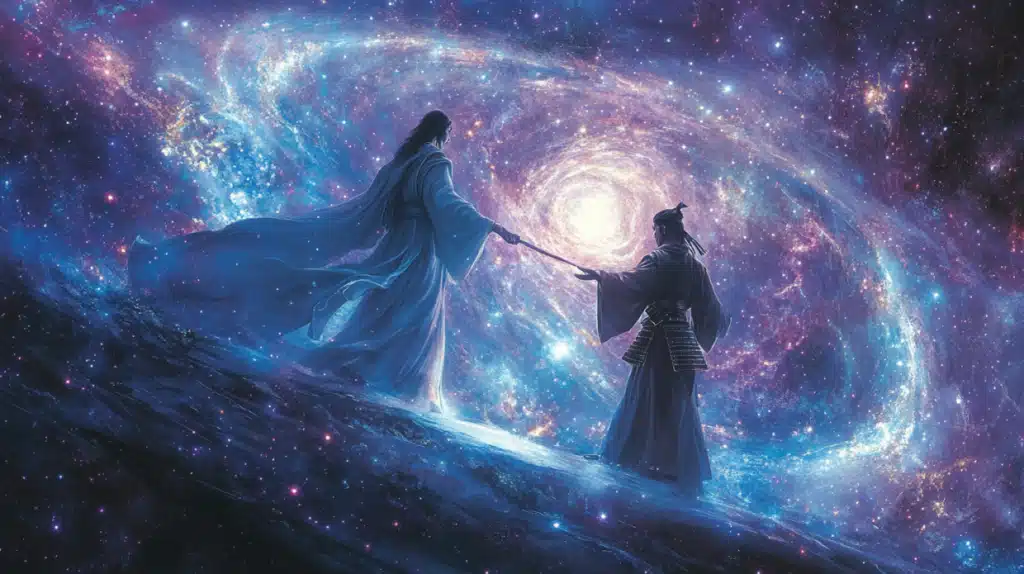
Conclusion: A Story Woven Through Cultures
Star Wars may be set in a galaxy far, far away, but it’s built on foundations that are strikingly close to home—particularly in Japan.
From the solemn code of Bushido to the introspective teachings of Zen Buddhism, from the sweeping cinematography of Akira Kurosawa to the graceful arc of a katana-turned-lightsaber, the Japanese influence on Star Wars is not just stylistic—it’s structural. It shapes the way the galaxy looks, feels, moves, and thinks. And it has helped anchor the saga in a kind of timeless storytelling that resonates across borders, languages, and generations.
George Lucas didn’t just borrow visuals from Japan—he borrowed values. He embedded Star Wars with philosophies about duty, detachment, and balance. He created Jedi who feel like monks and samurai in equal measure, characters who grapple with internal wars more than external ones. And he did it all through a cinematic lens inspired by one of Japan’s greatest storytellers, Akira Kurosawa.
That’s why, decades later, the stories still connect. Because behind the lightspeed jumps and laser battles is a quieter truth: Star Wars is as much about the soul as it is about spectacle.
Why This Legacy Matters Now More Than Ever
As the saga continues to evolve—through The Mandalorian, Ahsoka, The Acolyte, and upcoming films—the Japanese roots of Star Wars aren’t fading. If anything, they’re being rediscovered and celebrated more openly than ever.
Projects like Star Wars: Visions have turned Japanese storytelling into the main event, with anime studios crafting deeply personal interpretations of Jedi, Sith, and the Force—often with more philosophical depth than the mainline films.
And now, with Star Wars Celebration Japan 2025 on the horizon, the franchise returns to a place that helped shape it. Not as tourists, but as cultural collaborators. It’s a celebration not only of the franchise, but of the very cultural DNA that made Star Wars possible in the first place.
🇯🇵 It’s not just about looking back—it’s about honoring the past as a living force that continues to shape the future.
A Force That Connects Us All
Just as the Force connects all living things in the galaxy, the shared values between Star Wars and Japanese culture connect us across time and tradition. They remind us that storytelling is universal. That wisdom can be found in stillness. That true power comes not from domination, but from discipline. That balance is worth fighting for—whether in the real world or on the edge of the Outer Rim.
So the next time you see a Jedi raise a lightsaber, meditate in silence, or choose compassion over anger, remember:
You’re not just watching a sci-fi hero—you’re witnessing the echoes of centuries of Japanese philosophy and art, lovingly reimagined in a galaxy where old souls wear new robes, and ancient teachings still guide modern myths.


